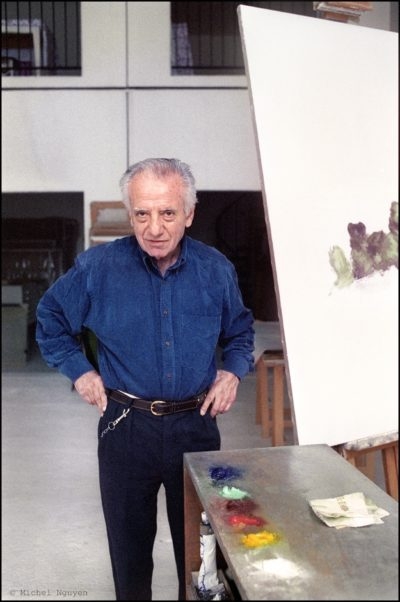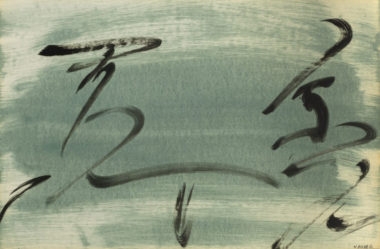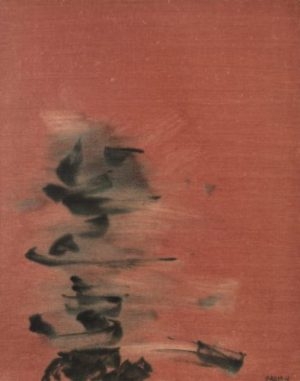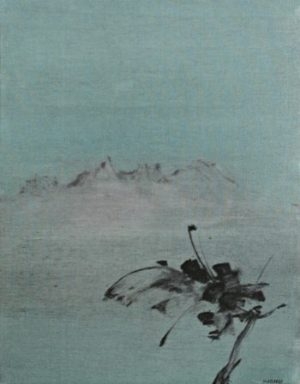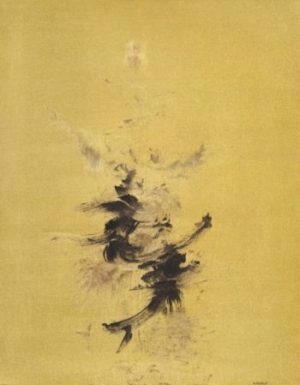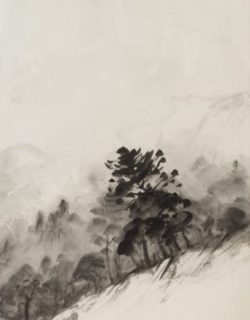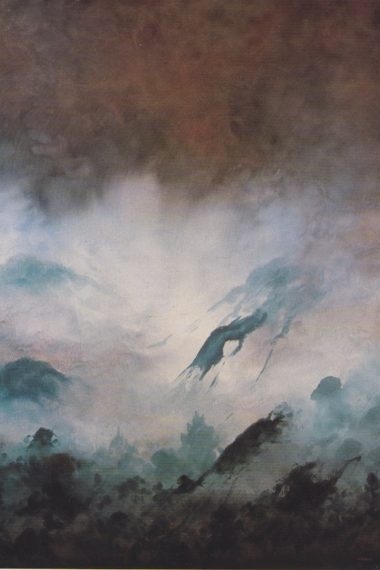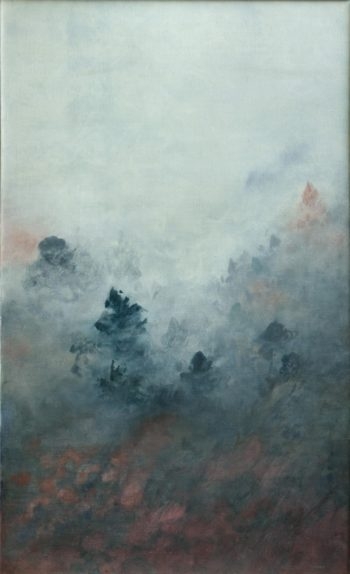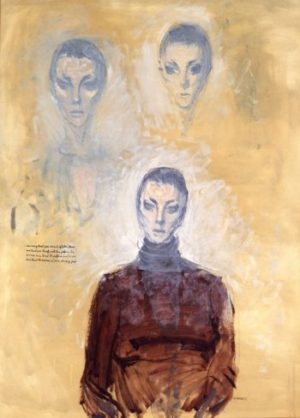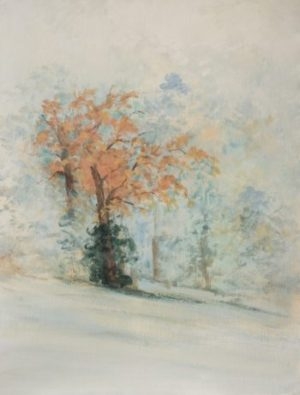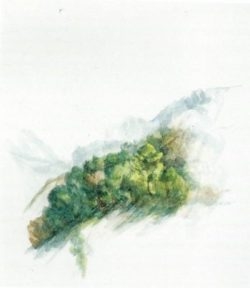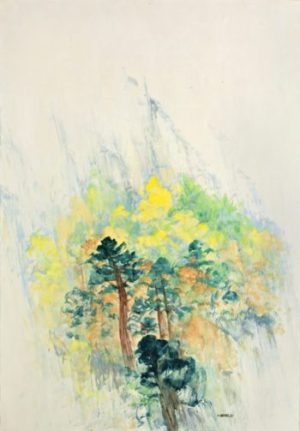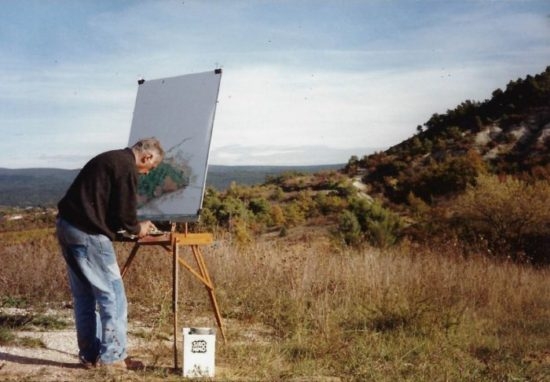Nasser Assar : a long journey
There is one feature that the work of Nasser Assar (1928-2011) shares with a rather small number of painters of his generation: the rejection of representation – rejected, only to be retrieved, slowly, gradually, around the 1960s, in several landscapes and portraits, as well as in some still lives, through the use of oil, watercolour and ink and wash. The term ‘rejection of representation’, rather than ‘abstraction’, is appropriate, because the painter’s earliest works, made up of signs, like the characters of a writing system unburdened by meaning, have little to do with a radical simplification or reduction, and even less with abstract reflection. Instead, they bear witness to a sometimes-exasperated impulse, and are in any case hard to master: an irrepressible thrust towards something indeed larger than a word, larger than a meaning. Something that could not be identified, in pictorial terms, with the automatic writing of the Surrealists (from the 1920s, André Masson memorably practised automatic drawing), where words, though clashing, preserve nonetheless the meaning and significance from which they are trying to ‘break free’; something that could not be identified with the dripping or pouring of Sobel and Pollock.
Sans titre, 1960, oil on paper mounted on canvas, 65,3 x 100 cm, Paris, private coll.
Although Nasser Assar’s early works are dominated by the power and the freedom of his gesture, they do not evince any effect of accumulation or superposition of colours. The isolated signs that, intermittently, characterise them stand out very clearly against a nearly always plain-colour background. Without wishing to be paradoxical, two observations can be made. On the one hand, the composition of these works remains quite classical, exuding balance and a certain elegance never shaken by the vigour of the gesture; on the other hand, the range of their colours is rather narrow, not seeking to impress, – so much so that one cannot easily connect them to any movement or school active in Paris in the 1950s, when Nasser Assar settled there. (By contrast, think for example of the creations of the so-called “Lyrical abstraction” of that period, embodied in the large, most confused and provocative, canvasses of a Georges Mathieu).
Sans titre, 1962, oil on canvas, 92 x 73 cm, Paris, private coll.
NASSERAs a matter of fact, from the mid-1960s on, something was rapidly to emerge. Where the characters of an imaginary or lost writing system were visibly deteriorating, vegetable forms sprang up. One may wonder about this unexpected mutation, and perhaps believe it to be not the result of the painter’s clear decision, but to have been achieved through an inner thrust of the signs themselves. Then comes the thought that, while many abstract works in those years indulged, no holds barred, in the ‘arbitrariness of the sign’ as a way of rejecting any a-priori constituted image, Nasser Assar gave up this pleasure and felt the need to oppose it. In doing so, he may have been offloading a burden from his past; a need, besides, which stemmed, here too, not so much from a firm desire or idea, as from something that was becoming progressively obvious. So much so that the painter’s strictly abstract period would appear as a waiting time rather than a time of conquest. In his work – and this applies equally to his last works – one doesn’t really find research as such, of the sort that one imagines in a Kandinsky, a Mondrian or even a Dubuffet. We find, instead, a surprisingly optimistic expectation that acts as research: something coming from outside must occur, which no concept, no theoretical reflection, no construction, could ever replace, and which, therefore, is worth waiting for. With some leaves, some twigs and branches having turned up overnight, faintly swaying in the wind, we are then presented with a most singular ‘execution’ of signs reverting to their pictographic beginnings, according to a kind of myth capable of recapturing in nature the elements of a primordial and sole ‘alphabet’.
Sans titre, 1965, oil on canvas, 92 x 73 cm, Paris, private coll.
NASSERRemarkably, however, in Nasser Assar’s paintings, in the same years, this evolution coincides with the emergence of a horizon – at first barely marked by simple tone variations of the same colour, for instance, a grey sky now lightly veiled by clouds, with the occasional dawn-tinged cloud bank; then, suddenly, almost abruptly, it was a horizon marked by a mountain range, which the viewer will identify as the Elburz range, north of Teheran, the painter’s native town, in particular the Damāvand peak. Clearly, it is a specific memory from his childhood and adolescence. We therefore observe a quasi-linear transition from a meaningless ‘writing’ – entirely made up of signs hazarded, as it were, not without vitality (or exasperation), into empty space, in search of who knows what – to the recollection of branches and foliage, which come to endow all these signs with meaning, by replacing them; it is even revealing to notice them making their gentle way into the paintings, growing within them, either from below or from above, with no intention to take up centre stage as if they were ‘mandatory’ motifs. And how moving, then, to realise that it is through them, thanks to them, that the artist’s memories begin to stir and awaken, unexpectedly: the world is conquered, or rather re-conquered, not through observation or contemplation, but through one’s memory. Who indeed could have predicted the advent – in a painter’s work initially so alien to any representation and almost feverish – of the calming image, in the distance, of a mountain range ?
Sans titre, 1963, oil on canvas, 92 x 73 cm, Madrid, private coll.
NASSERThis evolution prompts several considerations. To begin with, we get this sense that the artist’s early works were undoubtedly the result, not so much of a special affinity with clearly non-figurative forms of expression, as of a game of influences in the Parisian environment which, at the turn of the 1950s-1960s (Nasser Assar moved to Paris in 1953) saw the triumph of abstract painting, particularly the version known as ‘lyrical’, with artists such as Degottex, Hartung, Mathieu, Schneider, Szenes, and Vieira da Silva, and also witnessed the discovery of American painting. So, we can hardly believe that a young painter, still in search of his own style, would have missed, in Paris, in 1958, at the Galerie Kléber, the exhibition of paintings by Degottex, Fautrier, Hantaï, Mathieu, and Tobey. Nor would he have missed, the following year, the exhibition at Studio Facchetti (to mark the first ten years of activity), with works by Bryen, Dubuffet, Fautrier, Francis, Mathieu, Michaux, Pollock, Riopelle, and Sima. At the same time, however, we know for certain that during the same period Nasser Assar visited the exhibition, Orient – Occident. Rencontres et influences durant cinquante siècles d’art mounted by Musée Cernuschi (November 1958 – February 1959). There, he discovered, more particularly, the works of Kline, Tobey, and Zao Wou-Ki. In a way, nothing could have been easier or more ‘comfortable’, then, than to pursue, indefinitely, either one or the other direction indicated by all these artists. His return to a form of figuration, from 1963, is all the more surprising in that very few artists were seen doing the same thing, which in those years may have been considered a step backward, if not a retreat. There is of course the significant case of Nicolas de Staël, who had dared take a step backward from the early 1950s. Yet, he did so while following a path where memory played no role, hence a very different path from that of Nasser Assar. Where in the latter long signs – uncertain and impetuous as though yearning for a lost writing – end up connoting some branches and leaves, in the former we have robust compositions that, when colour is added, slowly recover the shapes of the visible world: the shape of a tree, a boat, a house, or a roof. Yet, in both cases the sincerity of the artists remains intact, and it isn’t hard to believe that, for both, abstraction was never anything but a necessary experience. How can we put it? Our overriding impression is that the abstraction of Nasser Assar’s early works displays impatience, anxious anticipation; in any case, nothing self-satisfied or smug.
Sans titre, 1976, wash on paper, 65 x 50 cm, Paris, private coll.
NASSERThis being the case, it would be foolish to identify and contrast two separate parts in Nasser Assar’s career while ignoring their continuity. In this respect, it is highly significant that in the skies of several landscapes he painted after 1963, we recapture, on the one hand, the very ‘substance’ that underpinned his abstract works, with subtle tonal variations of one or two colours; while in the dark outlines of the trees (nearly always firs and cedar trees) that stand out at the foot or on the side of the mountains, we recapture a little of the impetus of the signs drawn in these works, – a passion that could, moreover, reach as far as the skies, then streaked by stormy clouds. What we are faced with – very noticeably in his ink and wash paintings – is a kind of inversion or involution, whereby these black trees seem to want to re(turn) to the signs of a secret writing. More surprisingly still, these landscapes, painted approximately between 1965 and 1985, inspired by real places observed during long stays spent in the Haut-Var, in the surroundings of Fayence and Évenos, create such an unreal impression that one can only conclude they were ‘rethought’ and often, disturbingly, that they were rewilded and dramatized. The total absence of human presence or of anything akin to it – neither roof nor house, no road, no power poles or cables … – reinforces this impression. The least one can say is that the light of Provence is nowhere to be seen. (It is quite curious to realise how, there, the artist recaptured the restless and dreamy mood of several landscapes painted by Caspar David Friedrich in the region of the Riesengebirge, the Sudeten Mountains).
Voile déchiré, 1982, huile sur toile, 162 x 114 cm, New York, private coll.
NASSERAnd so, the evolution of the painter’s work undoubtedly meant less a return to the figurative, in the usual sense of the term, than a shift within the imagination, – whereby the hasty signs of an imaginary script give way to the long process of inventing an imaginary country, where it would seem hard not to want to pick up the scattered pieces of a long-gone past. We are not talking, therefore, of a slowly matured aesthetic choice, but of the pursuit of a (more or less conscious) form of memory search, something we are more used to in literature than in the fine arts.
L’hiver, le soir, 1982, huile sur toile, 146 x 89 cm, Paris, private coll.
This is why Nasser Assar’s work stands apart and has proved to be deeply personal, literally personal: which means that having quickly found its direction of travel, his work develops with no concern for the prevailing pictorial trends, escaping their influence altogether. Likewise, the fact, which can’t have left him indifferent, of meeting and rubbing shoulders with Francis Bacon in London in 1961, had no appreciable impact whatsoever on his work. Presumably, then, the inner resources of his work, their own riches and pressure, were such that the artist could in no way be very interested in the hundred aesthetic disputes and debates which the society of his time seemed to enjoy so much. It was literature, and especially the poets who were his friends and paid tribute to his work (John Ashbery, Yves Bonnefoy, Claude Esteban, Lorand Gaspar, Christian Guez, Jean-Paul Guibbert, Philippe Jaccottet, Alain Lévêque, Bernard Noël, Alain Paire, Herbert Read, Paul de Roux…) – without ignoring the influence of great figures from the past, such as T. S. Eliot or W. B. Yeats – that provided him with the support his uncertainties craved. No doubt, he found support in music, too. In truth, Nasser Assar’s essentially dreamy nature fed on non-visual languages more than on the language he practised. I have no memories of him ever drawing pleasure from discussing paintings that he may certainly have seemed to admire but to which, not without great elegance and a refined shade of humour, he remained somehow distant: perhaps, the despotism of memory can be such that it will lose interest in whatever does not affect it directly or might threaten to distract it.
Isabelle, 1977, oil on paper mounted on canvas, 105 x 75 cm, Paris, private coll.
NASSERIt is nonetheless worth noticing that one part of Nasser Assar’s work evades this analysis, while reasserting its dreamy nature: namely, the portraits of Isabelle, which the artist produced again and again after 1968. At first, we feel that he is not totally at ease as he practises a genre that a priori implied observation: strong and exacting observation, all the more so that his spouse was almost the only model he engaged. (He did also paint a portrait of Roger Munier as well as a series of female nudes with the title Régina, but they are not strictly speaking portraits, and he never exhibited them). It is also true that at the time one could not, clearly, practise this genre without the work of Giacometti occurring and recurring in one’s mind. Giacometti had died three years earlier, after a great international retrospective, which Nasser Assar visited in London in 1966. The recollection was daunting, a sentiment certainly perceptible in Isabelle’s quasi hieratic poses: in their frontality, their solemnity, their sternness even. One may also think, without forcing the interpretation, that the choice of representing a much loved person proved a ‘reality test’ for the artist, all the more difficult in that she diverted him from the usual reverie induced by landscapes, especially those perceived in the light of memory. Which confirms and clarifies, unexpectedly, the essentially imaginary nature of his relation with the world; for the hieratic tone of his portraits of Isabelle – though the term portrait doesn’t quite fit here – could very well expose a sort of interference of the imaginary, as a defence, wherever reality got too pushily in the way.
Sans titre, 1985, huile sur toile, 116 x 89 cm, Paris, private coll.
NASSERNow, the landscapes painted by Nasser Assar after the mid-1980s underwent a real change – a change, rather than an evolution, that was totally unexpected. On the one hand, the motif is observed more closely. On the other hand, the painter’s palette becomes decidedly brighter. That’s when we realise that the imaginary has taken a step back (look at the sky, for example, which has practically faded out; and so have the clouds, often unreal, and often present in earlier paintings). It was as if some details of the landscape, and particular clumps of trees especially, in the countryside of the Midi at Mormoiron, in Vaucluse, near Mont Ventoux, or at Montauroux, in the Var, in the end appeared to the painter as actual objects not only irreducible but also engaging, fit to replace any anxieties stirred up by memory and to induce rest, even an unexpected sort of joy. And so it was that working ‘outdoors’ became a necessity for him, in a very different mode from the one used before. It was a more genuinely attentive mode, and he devoted himself to it enthusiastically in his later years, reserving his attention for a few sites that he never stopped revisiting. We may be surprised by this change, all the more so in that Nasser Assar could have stuck to his dreamlike landscapes – fed by the imaginary, bound up with the imaginary – which he painted for so long that it was to be feared that his work could become repetitive. (It is also true, however, that some of these since then ‘forgotten’ landscapes exuded anxiety, likely now to shatter their unity, to break them up and now to bury them in shadow; which indirectly points to an understated desire for rest, finally achieved.) ,,,,,,,,,,,,,,,,,,,,,,,,,,,,,,,,,,,,,,,,,,,,,,,,,,,,,,,,,,,,,,,,,,,,,,,,,,,,,,,,,,,,,,,,,,,,,,,
NASSERThe most moving aspect of all this is that, freed at last, one might say, from old and hollow musings, this gaze does not lead the artist to a true descriptive realism. The colours chosen – the greens, yellows, the browns and the blues, whether oil or watercolour (used more frequently from now on) – appear so fresh and so intensely bright that the trees thus represented, be they en masse or individually, convey both the cheerful energy and the beneficial character of large bunches of flowers, offered and received like gifts from Nature.
Route de Blauvac, 2000, watercolor, 64 x 50 cm, Paris, private coll.
Indeed, in these paintings, the light seems to radiate from inside the foliage rather than from the sun. What emerges, therefore, is precisely a whole effort of interiorisation through colour. Thus, we understand that the ‘solution’ the painter was looking for had nothing to do with appropriating, more or less dramatically, a vacant space, which invariably makes room for the blurry game of memories; instead, it had to do with a calm and cautious approach to the resources of the colours of nature, where the imaginary world becomes more simple. And this clarifies, a-posteriori, the fact that, without a proper explanation, Nasser Assar was never fully acknowledged as a member of the Nuagistes. Yet he did exhibit his work alongside theirs in the 1960s, although, by their own admission, for them nature was totally irrelevant.
NASSERBe that as it may, one thing matters, and we need to establish the coherence of the painter’s ‘journey’, to retrace all the steps in order to understand its logic. He set off with a clean slate as it were, close to the all over of American painting, with only a few uneven and nervous signs (the remains or forerunners of a script in quest of a meaning), signs that were soon to be allowed to take on vegetable shapes. With these shapes he discovers or retrieves, though totally steeped in a dream world, a certain feeling of the presence of nature, in the midst of large landscapes where, at the foot of rugged mountains shrouded in mists, emerge trees with knobbly trunks and dark foliage, eerily reminiscent of signals. And there is no denying that these landscapes are very strange, calling to mind no known region, inhabited by nothing human, and inclined to fascinate rather than seduce; there is something unsettling always trying to dissolve within them, never succeeding. The opening up of space looks deceptive: the eye collides with an illusion and finds no peace, incessantly reminding us of primordial chaos, where two elements, air and earth, struggle to stand out individually, just as colours do – and if we worry that the work might become repetitive, as we said, we may likewise suppose that it could then revert to a form of abstraction.
Ravin de Saint-Cézaire, 1985, huile sur toile, 116 x 81 cm, Paris, private coll.
NASSERNow, the ‘solution’ did not come from such an improbable return, but – and it is in this respect remarkable and unexpected, if not almost daring for his time – from a return to the former practice, somewhat brought into disrepute by the universal success of the Impressionists, of painting ‘outdoors’, in other words to a direct approach to nature, pointing out a renewed trust in it. ‘New’: insofar as this approach is not limited to the sole aim of reproducing as accurately as possible the effects of the light on the countryside, on water, on snow, etc., as was the case precisely with the Impressionists; instead, here it turns into the almost contemplative quest for a primeval burst, an outpouring of colours reminiscent of the Fauves, except that with them, more perfunctorily, it was a case of the painting itself, of freeing colour of any dependence vis-à-vis such or such motifs, no matter which in the end.
Route de Blauvac (Vaucluse), automne 1995
With Nasser Assar, conversely, the eye connects and engages profoundly with nature (and you could hardly imagine him painting houses, bridges or boats in the same way). In nature, indeed, he discovers a peculiar source of energy, which very conveniently shrinks the part played by this strange, old personal imaginary that had for so long ‘held’ him and somehow exhausted him in a kind of nervous oneirism. Happiness, one feels, was reached then, in those oils and watercolours of his later years, a joy that the artist does his best to share by fastening his motif in the middle of the canvas or of the blank page, the way one ties a spray of flowers, thereby suggesting, precisely through its observation, something that both falls short and goes beyond the motif, at the heart of the motif itself. Today there are good reasons to look forward to seeing such a long personal journey end thus, with the utmost simplicity, naturally, in something other than an idea or a show of strength.
Alain Madeleine-Perdrillat
July 2019
Translated by Simona Cain
September 2020


